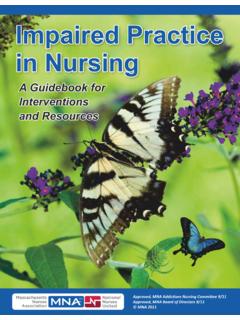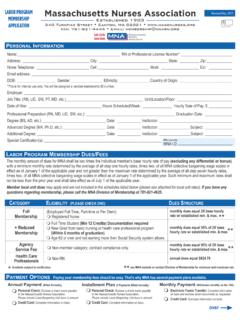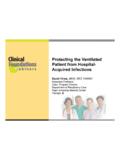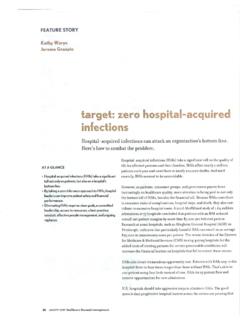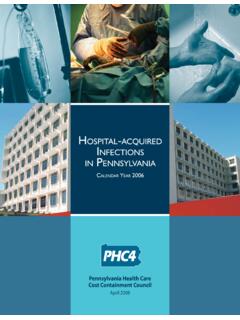Transcription of Nurse Staffing and Healthcare- associated Infections
1 314 JONA Vol. 32, No. 6 June 2002 The nation is facing a nursing shortage that is creat-ing a crisis for quality healthcare and patient has documented that problems with nursestaffing are associated with Healthcare- associated in-fections and other adverse events that affect patientoutcomes. These ominous facts, stated during theopening of an expert consultants meeting convenedby the Division of healthcare Quality Promotion,Centers for Disease Control and Prevention, laid thefoundation for a day-long discussion and a call to ac-tion to address a growing crisis in au-thors summarize the proceedings of this meetingand present the consultants suggestions for drawingnational attention to this July 9, 2001, the Division of healthcare QualityPromotion (DHQP), National Center for InfectiousDiseases (NCID), and the Centers for Disease Con-trol and Prevention (CDC) convened the WorkingGroup on Nurse Staffing and Healthcare- AssociatedInfections in Atlanta, Georgia.
2 The purpose of themeeting was to exchange information and researchon the association between Healthcare- associated in-fections and Nurse Staffing and to provide input tothe CDC and nursing leadership about steps neededto address this issue. Participants included recog-nized experts in the areas of both Nurse Staffing andhealthcare- associated Infections , as well as represen-tatives of stakeholder organizations (Appendix).DHQP s interest and role in this arena are wellestablished. As noted by Julie Gerberding, MD, MPH,in her opening remarks, DHQP has been given thelead in patient safety activities at CDC and has beendesignated as a representative to the 4-agency Fed-eral Patient Safety Task Force, which is charged withcoordinating the integration of data collection onmedical errors and adverse events, coordinating re-search and analysis, and promoting collaborative ef-forts to improve patient safety.
3 These activities willcontribute to efforts to meet the goal in the 1999 In-stitute of Medicine1report,To Err Is Human: Build-ing a Safer Health System, of reducing the numberof medical errors by 50% over 5 also has 7 healthcare safety challenges toreduce or eliminate targeted Healthcare- associatedinfections and occupational exposures during thenext 5 years. Because the ability to achieve these ob-jectives is highly dependent on a strong infrastruc-ture in healthcare organizations, DHQP is committedto addressing the essential components of such aninfrastructure. Two major factors are likely to influ-ence the potential for success: computer decisionsupport and Nurse meeting was organized around 3 basicthemes: 1) examination of the scientific evidence onthe relationship between Nurse Staffing and patientoutcomes; 2) understanding system factors that in-fluence Nurse Staffing ; and 3) identifying strategiesJONAV olume 32, Number 6, pp 314-322 Nurse Staffing and Healthcare- associated InfectionsProceedings From a Working Group MeetingMarguerite Jackson, PhD, RN, FAANL inda A.
4 Chiarello, MS, RNRobert P. Gaynes, MDJulie L. Gerberding, MD, MPHAA uutthhoorr aaffffiilliiaattiioonn::Department of Education Development andResearch, University of California at San Diego, Calif (Dr Jackson)and the Division of healthcare Quality Promotion, Centers for Dis-ease Control and Prevention,Atlanta, Ga (Ms Chiarello, Dr Gaynes,and Dr Gerberding).These proceedings are being published simultaneously in theAmerican Journal of Infection Controland the Journal of Nurs-ing aauutthhoorr::Linda A. Chiarello, MS, RN, Division ofHealthcare Quality Promotion, Centers for Disease Control andPrevention, 1600 Clifton Rd, E-68,Atlanta, GA Vol. 32, No. 6 June 2002315for effecting change. Formal presentations precededa discussion of the available articlesummarizes the proceedings from the meeting andpresents several strategies for future Staffing and DemographicsPeter Buerhaus, PhD, RN, FAAN, provided insightinto how increasing societal demands for health-care and organizational demands for registerednurses (RNs) will be affected by the changing de-mographics of the Nurse work force in the UnitedStates.
5 Several factors that influence society sgrowing demand for healthcare that directly affectthe nursing work force were noted: increasinghealthcare requirements in the aging populationand in a growing general population; the presenceof more elderly and acutely ill patients in hospitals;increasing use of medical and information technol-ogy; current and future economic trends; and na-tional healthcare policy initiatives. Increasing orga-nizational demands specifically for RNs also can beexpected as a result of the regulatory emphasis onquality of care and organizational emphasis on pro-ductivity, efficiency, and compe-tition for current and future RNs also is influencedby a lack of good RN light of this increasing demand, trends in andforecasts of the future supply of nurses are average age of the RN work force is increasingmore than twice as fast as that of all other occupa-tions in the work force.
6 Between 1983 and 1998,the number of RNs younger than 30 years decreasedby 41%, whereas the number of persons in the force in that age group declined by only 1%.One result of this large decline is that the nursework force is dominated by older workers (goodnews in terms of accumulation of knowledge andexperience but bad news in terms of physical en-durance).Moreover, conservative projections show a lev-eling off in total RNs in the work force in 2008 2009, followed by a decrease as current nurses reachretirement age. Thus, the RN work force will beshrinking in size while those who remain in thework force will be significantly older at a time whensociety will need RNs most, resulting in a large dis-parity between supply and demand. This gap be-AppendixWorking Group AttendeesG. Rumay Alexander, MSN, EdD, RN American Organization of Nurse ExecutivesMonica Berry, BSN, JD, LLM, FASHRMA merican Society for healthcare Risk Manage-ment and American Hospital Association Mary Blegen, PhD, RN University of Colorado Health Science Center Barbara I.
7 Braun, PhDJoint Commission on the Accreditation of healthcare OrganizationsPeter Buerhaus, PhD, RN, FAAN Vanderbilt University School of NursingNancy E. Donaldson, DNSc, RN University of California at San Francisco Schoolof NursingJudith F. English, RN, MSN, CIC Association for Professionals in Infection Control and Epidemiology, Inc Lynda Flynn, PhD, RN, CS Center for Health Outcomes and Policy Researchand University of PennsylvaniaJudy Goldfarb, MA, RN,Centers for Medicare and Medicaid Services (formerly Health Care Financing Administration)Marguerite Jackson, PhD, RN, FAAN University of California at San DiegoElaine L. Larson, PhD, RN, FAAN Columbia University School of Nursing Patricia Rowell, PhD, RN American Nurses Association David Warren, MD Washington University School of Medicine Michael Williams, RN, MSN, CCRN American Association of Critical-Care NursesCenters for Disease Control and Prevention Staff Lennox , MD, MRCP (UK), DTM&H Juan Alonso-Echanove, MD Linda A.
8 Chiarello, RN, MSRobert P. Gaynes, MDJulie L. Gerberding, MD, MPHJohn Jernigan, MDLynn Steele, MPH316 JONA Vol. 32, No. 6 June 2002tween supply and demand already is serious in manynursing specialty areas, such as critical care and op-erating room problem is exacerbated byexpanding employment opportunities for women inmany different fields and declining interest in nurs-ing as a career, particularly among young ,8 During the past few years, there has been con-siderable interest in evaluating whether there is a re-lationship between Nurse Staffing and patient out-comes. Most recently, Needleman and colleagues9reported results of a government-funded study to de-termine whether there is scientific evidence for a re-lationship between patient outcomes that are po-tentially sensitive to Nurse Staffing and Nurse staffingin inpatient units in acute care hospitals.
9 The re-searchers analyzed data from more than 5 millionhospital discharges in 11 states and more than 12million Medicare beneficiary discharges in morethan 3,000 hospitals nationwide in 1997. Strong andconsistent relationships were found between nursestaffing variables and 5 outcomes in medical patients(urinary tract Infections , pneumonia, length of stay,upper gastrointestinal bleeding, and shock). In pa-tients who underwent major surgery, the only strongand consistent relationship was between nursestaffing and failure to rescue. *For outcomes associ-ated with Nurse Staffing , higher RN Staffing was as-sociated with a 3% to 12% reduction in findings have generated substantial inter-est from the public, media, government, policymak-ers, and special interest groups. This interest willlikely focus attention on quality related to hospitalnurse Staffing , increase demand for regulatory over-sight and mandatory Staffing requirements, and in-crease union of these responses pose ad-ditional challenges, given the current nursingshortage and long-term implications of a rapidlyaging work suggested that the overall policy strat-egy should be to link aging and shortages with nursestaffing and quality rather than to view them as in-dependent problems.
10 The goals should be: to usewhat is known about healthcare quality and nursestaffing; and for policymakers, healthcare organiza-tions, nursing and physician leaders, and others tocollaborate to address this critical healthcare , these stakeholders can obtain organiza-tional support and resources to build a better in-frastructure that supports nurses in the work forceand make changes to support the Nurse that a decreasing supply ofnurses is inevitable, policymakers must prepare foran older work force, develop better ways to usescarce RNs, prepare for smaller enrollments inschools of nursing, design education for nurses toprepare them for roles in nonhospital settings, andavoid implementing hospital Staffing identified several strategies to in-crease the supply of include improvingthe image of nursing, reducing the costs of educa-tion, eliminating stigmas and barriers for men andminorities to become nurses.

